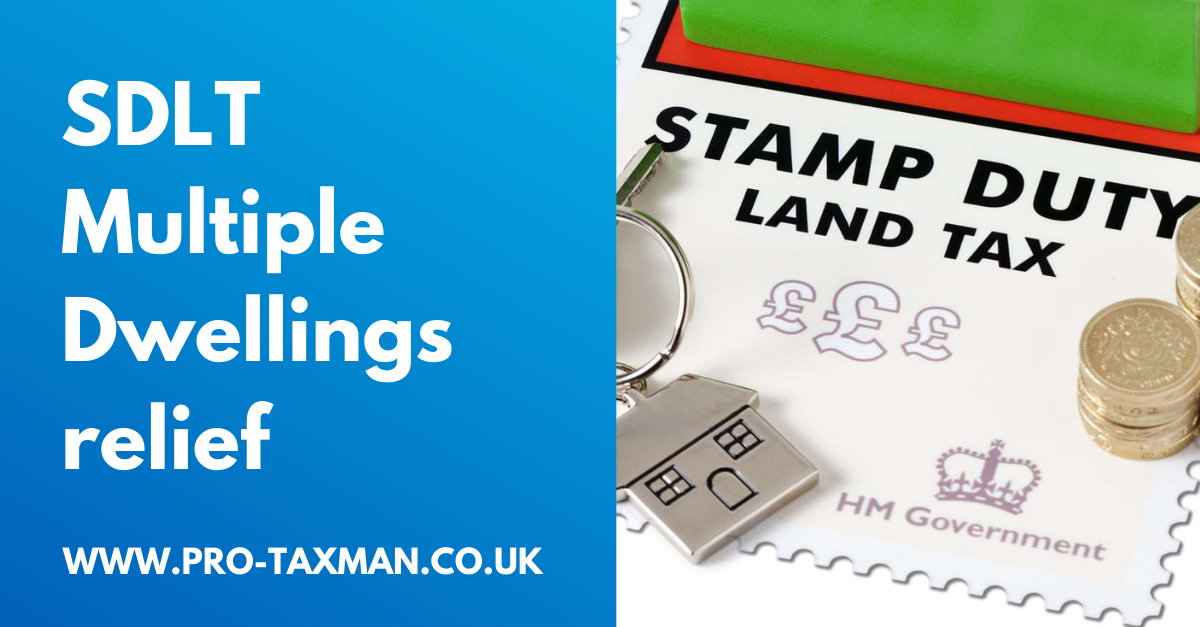Multiple dwellings relief’ (MDR) allows a rate to be charged at the percentage payable on the ‘average value’ price (referred to as the ‘Average Value SDLT’ (AVSDLT)) should more than one property be purchased at one time, rather than on the total consideration. MDR is only available for residential transactions.
The purpose of this relief is to simplify the calculation of SDLT when a single transaction includes the purchase of more than one dwelling. As such, rather than separately calculating the SDLT on each property acquired, SDLT is computed as follows:
- Calculate the ‘AVSDLT’ i.e. total dwellings consideration/ total number of dwellings.
- Multiply the resultant figure by the total number of dwellings.
The answer is the total SDLT liability.
NOTE 1: The SDLT must be at least equal to 1% x total dwellings consideration.
NOTE 2: the dwellings are not the main residence of the purchaser and as such the additional rate of 3% applies.
Basic example
A single transaction (post 1 October 2021) comprises the purchase of 4 ‘dwellings’ for £950,000.
- £950,000/4 = £237,500 per dwelling
Tax per dwelling =
- 3% x £125,000 = £3,750
- 5% x £112,500 = £5,625
£9,375 x 4 dwellings = £37,500
The minimum tax is 1% of the purchase price = £9,500
Tax payable without claiming MDR would be £67,250.
Definition 1: ‘Dwelling’
Legislation does not define ‘dwelling’ but is widely accepted as being a building or part of a building that accommodates all of a person’s basic domestic living needs. The definition has seen granny annexes, converted garages, pool houses, converted party barns and garden offices all qualify for the MDR relief.
The nearest the legislation gets to providing a definition is FA 2003 sch 6B para which states that a dwelling is:
‘A building or part of a building counts as a dwelling if-
- It is used or suitable for use as a single dwelling, or
- It is in the process of being used constructed or adapted for such use.’
One area where there have been several tax cases that have considered this definition centre round ‘granny flats’. HMRC has confirmed that provided the granny flat is a self-contained dwelling and the main house comprises more than two thirds of the total, then MDR can be claimed. One of the main issues is where a property has an additional dwelling that cannot be accessed independently. For example, in a recent tax case relief was refused as there was no door separating the house from its annexe; it also did not have a separate postal address, council tax or utility supply.
The relief does not apply to the transfer of a freehold reversion or head lease where a dwelling has a long lease of 21 years or more.
Definition 2 – ‘Single transaction’
MDR can be claimed where the transaction involves an interest in at least two dwellings or at least two dwellings and some other property.
Where six or more separate dwellings are the subject of a single transaction involving the transfer of a major interest in, or the grant of a lease then the SDLT rules treat those dwellings (for that transaction alone) as being non-residential property. This rule applies automatically. Therefore, depending on the figures, it might be better not to make an MDR claim. If one is made it is made on a land transaction return (due within 30 days of completion) or in an amendment to a return, the time limit for which is 12 months from the filing date.
Need professional accounting service or accounting advice? Contact us to book a 15-min Free Consultation with us today.
To find out more please follow us on Facebook , Twitter or LinkedIn. Feel free to contact us on 0333 006 4847 or request a call back by texting to 075 6464 7474.

